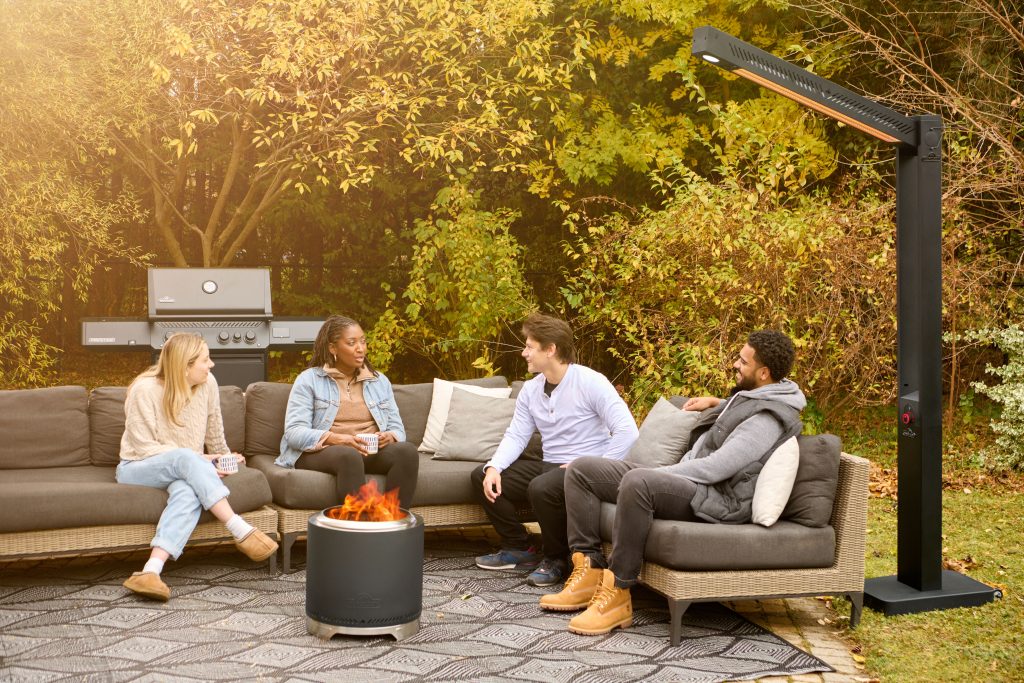If you want to enjoy your outdoor spaces more, you may be exploring patio heaters. By adding warmth to your patio, porch or deck, a patio heater allows you to stay outdoors later into the evenings, and longer into the Fall. It also means you can start enjoying your backyard earlier in the Spring. Basically, patio heaters help to mitigate the impact of unpredictable or changeable weather. They may be fueled by propane, natural gas, or electricity.
An electric patio heater has many advantages over a gas heater:
- No need for propane tanks or gas lines;
- Sleek designs with glass and stainless steel;
- Flexible installation options, with or without a stand;
- Range of sizes and heat outputs to suit different spaces;
- Zero carbon emissions that contribute to climate change;
- Zero carbon monoxide off-gassing that is dangerous to our health.
An electric patio heater acts like the sun, using radiant heat to warm up the people and objects below. Best of all, that heat can’t be pushed away by the wind. To figure out the optimal size and quantity of patio heaters, check the specifications to see the heating area for each model, then be sure your heaters are positioned so the heating areas overlap.
Because of the differences, there are more ways to use an electric patio heater than a gas heater. There are the usual outdoor installations, but we have a few more ideas that take advantage of the safety and convenience of electric patio heaters.

Outdoor dining under a pergola
Al fresco dining has never been more popular. Who doesn’t want to enjoy eating outside when the weather is warm?! Many restaurants and bars have taken advantage of this trend by adding patio heaters to their outdoor spaces. You may have seen those bulky heater stands with propane tanks, sitting between the tables. However, if you’ve been dining outdoors and did NOT notice where the heat was coming from, chances are that there were sleek electric patio heaters overhead. Because of their directed radiant heat, it’s safe to install electric patio heaters near the top of an overhang, as long as they are out of reach of the people below. With the click of a remote or switch, these heaters can be turned on or off, up or down, as needed to adjust to changing conditions. Wall-mounted electric patio heaters come in 120 or 240 volts, in a range of wattages, depending on the type and number of bulbs they have.
Relaxing on the porch
If you love your front porch, you likely want to spend more time out there. Adding a sleek electric patio heater under the ceiling is a great way to make your porch more comfortable so you can use it more often. Think of it as being as essential as bug screens – without them, you won’t enjoy the porch as much. The same is true of a gazebo, if you’re lucky enough to have one. While a propane heater on a stand will take up valuable floor space, a wall-mounted or ceiling-mounted electric heater will be unobtrusive until you need it. You can also install multiple electric heaters, to ensure that all areas of the porch are warm.

Outdoor grilling on the deck
Canadians are a hardy lot, and many of us take pride in grilling year-round. However, Napoleon has recently introduced a freestanding, portable electric patio heater that could be a game-changer for cold-weather grilling. You can set it up next to your grill, angle the heating arm over the grill, or over your comfy deck chair, and keep cozy while the food cooks. It also has a light in the end of the arm, so you can see what you’re cooking. Of course, if your BBQ is on the deck or patio and you have wall-mounted electric patio heaters, you can switch one on near the grill, for the same effect.
Driveway repair zone
Napoleon’s Phantom portable electric patio heater is also a great option if you’re doing bicycle or lawnmower maintenance on the driveway in front of the garage. Just plug it in and roll it over to where you’re working. You’ll have heat and light to keep working even on a cooler day. There’s an extra-long 8-foot cord, for flexible positioning. You can even use it inside the garage, if that’s where you do your repairs. Because it is not fueled by propane, there’s no risk of carbon monoxide poisoning, so you can keep the garage door closed to keep out inclement weather.
Workshops & Unfinished Basements
If you’re lucky enough to have a workshop to do repairs and projects, you can make it more comfortable by installing wall-mounted electric patio heaters near the ceiling. Just be sure that you observe all clearances to the ceiling and other objects. They should also be high enough that they can’t be reached by outstretched hands, to avoid burns. The freestanding Napoleon electric patio heater would also work well in this situation, if floor space allows.
Sometimes, the ‘workshop’ is in the basement. Any Canadian with an unfinished basement knows how cold they can be, especially in Winter. Wall-mounted electric outdoor heaters are safe for indoor use as long as minimum height requirements are met to keep the hot elements out of reach. Mount one near any work zones, so you can make better use of your basement year-round.
Summary
As you can see, an electric patio heater is more than just an outdoor heater. Because they are not producing dangerous carbon monoxide, they can be used indoors as well as outdoors, anywhere that you want to extend your use of the space in colder temperatures.